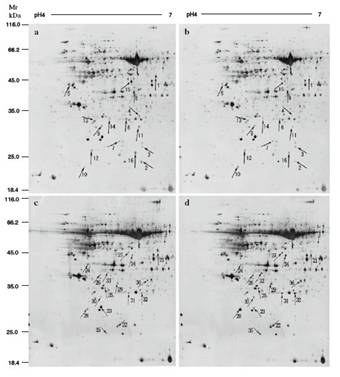Comparative Proteome Analysis of Metabolic Changes by Low Phosphorus Stress in Two Brassica napus Genotypes
2011-12-30
Low availability of phosphate (Pi) to plants in soil is a major constraint for crop production. It is estimated that majority of planting areas for Brassica napus in Asia are currently phosphorus deficient. The phosphorus availability is further restricted by low temperature in the growing seasons of B. napus. For these reasons, Pi input per hectare in Brassica is much higher than other crops. On the other hand, excessive Pi added to soil can pollute watercourses and contribute to the process of eutrophication. It is therefore essential to develop efficient B. napus cultivars capable of using phosphorus more efficiently in order to minimize application of P fertilizers.
In an attempt to determine the adaptation strategy to phosphorous (Pi) deficiency in oilseed rape, comparative proteome analyses were conducted to investigate the differences of metabolic changes in two oilseed rape genotypes with different tolerance to low phosphorus (LP).
Generally in either roots or leaves, there existed little low phosphorus (LP)-induced proteins shared in the two lines. The LP-tolerant genotype 102 maintained higher Pi concentrations than LP-sensitive genotype 105 when growing hydroponically under the 5-μM phosphorus condition. In 102 researchers observed the downregulation of the proteins related to gene transcription, protein translation, carbon metabolism, and energy transfer in leaves and roots, and the downregulation of proteins related to leaf growth and root cellular organization. But the proteins related to the formation of lateral root were upregulated, such as the auxin-responsive family proteins in roots and the sucrosephosphate synthase-like protein in roots and leaves. On the other hand, the LP-sensitive genotype 105 maintained the low level of Pi concentrations and suffered high oxidative pressure under the LP condition, and stress-shocking proteins were pronouncedly upregulated such as the proteins for signal transduction, gene transcription, secondary metabolism, universal stress family proteins, as well as the proteins involved in lipid oxygenation and the disease resistance in both leaves and roots. Although the leaf proteins for growth in 105 were downregulated, the protein expressions in roots related to glycolysis and tricarboxylic acid (TCA) cycle were enhanced to satisfy the requirement of organic acid secretion. The results not only enhance the knowledge about molecular processes associated with Pi deficiency, but also facilitate the exploration of key molecular determinants for Pi uptake and translocation.
This work has been published on Planta, 2011, 233(3): 523-537. The paper is also archived at http://www.springerlink.com/content/p1v4014q631n7q02/.

Representative 2-DE gels of leaf proteins in lines 102 and 105 under sufficient (1,000 μM) and low (5μM) phosphorus (SP and LP) conditions. a The SP-treated sample of 102 leaves. b The LP-stressed sample of 102 leaves. c The SP-treated sample of 105 leaves. d The LP-stressed sample of 105 leaves.



